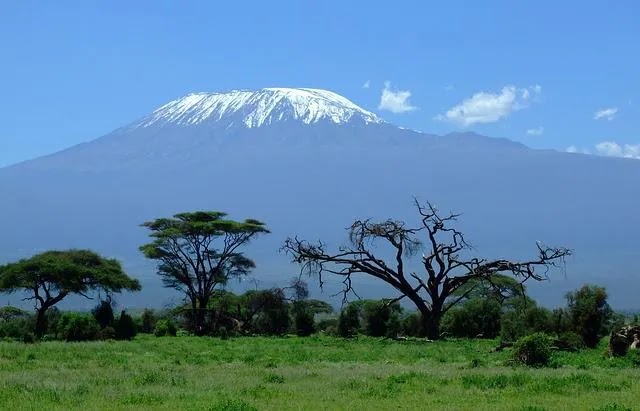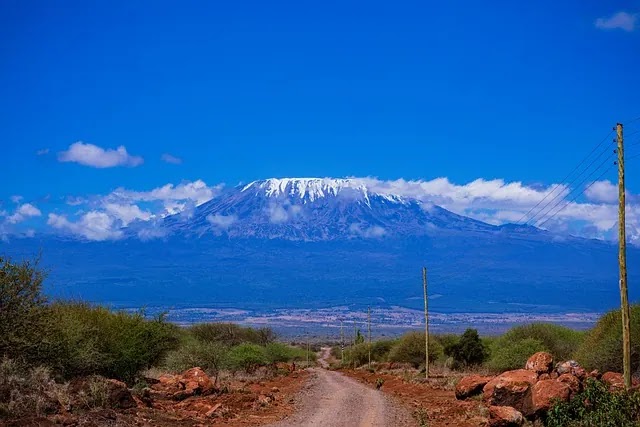The largest mountain in Africa is one of the most well-known mountains in the world. You may consider it a bucket list destination for travelers from all across the globe.
It is possible to see snow-capped peaks and lush green forests on this magnificent hill. This mighty hill can take your breath away with its beauty, without any doubt.
What makes Kilimanjaro stand out as an ideal adventure travel destination? Let us find out in this fantastic article about this mountain!
There are several other mountains with similar names in different locations. But Mount Kilimanjaro is the one that stands out as a tourist attraction.
The Largest Mountain in Africa
Africa is a great continent where you will see many wonders of nature. Mount Kilimanjaro, one of the wonders of nature, is an African volcanic peak.
This hill is in the north of Tanzania and is the most notable peak in the African continent. This mountain formed over the years as the geographical remnants of the volcanoes.

This mountain has borders with Kenya, Mawenji, Shira, and Kibo. According to geographers, the mountain formed about 3 million years ago.
The highest peak of Mount Kilimanjaro is 5,895 meters. It has the highest peak on the African continent. This mountain has taken place in the list of the six highest peaks of that continent.
The locals have a beautiful name for its peak – ‘Uhuru’. The word in Swahili means liberation or freedom. This magnificent peak in Africa is independent.
Most of the mountains in the world are part of one or different mountain ranges. For example, let’s talk about Mount Everest.
Everest, the highest peak, stands in the middle of hundreds of mountains in the Himalayas. But the notable peak in Africa does not belong to any mountain range.
This great mountain of Africa is in the highest peak in the list of free-standing mountain peaks. Volcanic eruptions are the cause of the formation of these types of mountains.
You will find the existence of mount Kilimanjaro in the pages of history through Ptolemy. The Tanzanian peak remains mentioned as a snow island in the sky.
Various nomadic tribes have settled at the bottom of the mentionable peak in Africa. This mountain is fertile with snow water from time immemorial.
Archaeologists in the area have unearthed traces of the ancient agrarian society. These patterns will not be so noticeable now because of the evolution of time.
The region was also important to Chinese and Arab merchants. Many Chinese scholars of the 6th century mentioned this mountain in their manuscripts.
The mountain, composed of lava, ash, and rock, is a stratovolcano. As a result, there is no possibility of the eruption of these two in the future.
But another volcano, Kibo, is now dormant. But eruptions have not occurred here in the last 10,000 years. The eruption of the Kilimanjaro volcano occurred 360,000 years ago.
Kibo’s position is between Shira and Mawenji. It is the highest volcano in Kilimanjaro, and its peak is the highest peak in the whole of Africa.

This peak was shaped about 4 lakh 60 thousand years ago from today. Mawenji’s height is 3,825 meters. It is the 3rd highest peak in Africa. Other volcanic veins are no longer considered peaks.
The position of this great African mountain is 205 miles from the equator. The equator divides the world into two parts, the northern and southern hemispheres.
In the equatorial region, the sun gives heat. So the temperature remains higher. For this reason, ancient explorers become astonished by the sight of the ice on the summit.
But because of climate change, the amount of this ice continues to decrease with the passing of the year. In 2011, its area decreased about 85% to 1.76 sq km.
Scientists feared that the ice of this mountain may lose in 2040. But, environmentalists have defined deforestation as the main reason behind global warming.
That is why concerned people planted about 5 million trees at the foothill of the mountain in 2008. They aim to protect the ice of the notable peak in Africa.
There is another unique peculiarity of the notable peak in Africa. You will see five different climatic layers from the foothill of the mountain to the top.
The climate near the foothills is temperate and static throughout the year. Cultivable climate dominates up to an altitude of about 1800 m. Then the rainforest level begins.
The temperature here is a bit warm, and the air is humid. The wetland climate level begins after an altitude of about 2800 meters.
The air from the rainforest is drier, and the temperature is lower. The desert climate starts at an altitude of 4,000 meters. There is no smell of life here.
The Arctic climate level remains exist at 5,000 meters to the top of the mountain. This layer is rocky and covered with ice. The diversity of climatic variations has made it unique.
Current Conditions
Though the inside of the volcano is dormant, events on top of the peak attract attention. The most recent glacier cap on the summit of the peak has receded.
The ice cap has decreased by more than 80%. An Ohio State University ice core paleoclimatologist did a study in 2002.
They said between 2015 and 2020, the ice on top of Africa’s tallest peak would disappear. According to Austrian researchers, the Plateau ice cover will disappear by 2040.
These researchers are from the University of Innsbruck. Some ice on the slope will last longer due to regional meteorological circumstances.
Researchers compared the ice core records of this mountain. Results of this comparison show that today’s climate is like that of 11,000 years ago.
The concerned authority finds some new information according to a study by researchers. Georg Kaser of the University of Innsbruck in Austria is one of the researchers.

The University of Washington is another. They said solar radiation is the cause of the shrinking of the ice cap rather than global warming.
The Tanzanian authorities had shut down the Western Breach route in January 2006. They shut it down after a rockslide at Arrow Glacier Camp took the lives of four persons.
The frost activity in this area brought the rockslide. That means this area was no longer completely frozen. Many expeditions had planned to use the Western Breach route.
But it switched to the Lemosho/Barafu route. It happened after the Tanzanian government closed it in January 2006.
This route begins from the west and ascends Shira Ridge toward Lava Tower. It is like the Western Breach route.
Instead of climbing to Glacier camp and the breach, this route circumnavigates Kili. It also heads south into Barafu Camp.